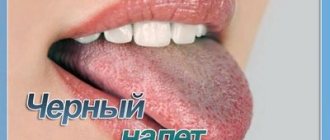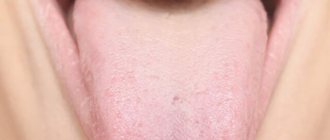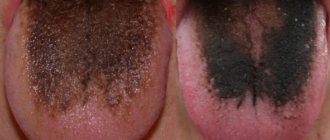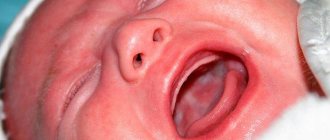What can a coating on the tongue indicate? Diagnosis of diseases using the tongue.
What health problems can our tongue indicate? Which doctors should you contact if you find a coating on the surface of your tongue? Let's figure it out.
The tongue helps to identify any dysfunctional processes in the body. Since ancient times, doctors examined the patient's tongue to clarify the diagnosis. Nowadays, diagnosing diseases by plaque on the tongue has not lost its relevance. Examining the patient's tongue is one of the doctor's algorithms during the examination.
White coating on the tongue in infants and newborns: causes and treatment
Infant's tongue
- The surface of a small child's tongue is smooth and moist and pale pink. Since the baby's main diet is mother's milk, the baby's tongue may have a slight white coating on the tongue. This is normal if the baby feels great, has a good appetite and sleeps.
- If not only the child’s tongue becomes white, but also the gums and the inner surface of the cheeks, he is capricious and eats poorly, then most likely this is the result of the vital activity of the fungus of the genus Candida. The disease is called thrush .
- White plaque literally envelops the entire oral cavity and tongue of the child. The disease occurs when the immune system is weakened and infection is introduced through dirty pacifiers, pacifiers, toys, or an infected mother.
- Thrush newborn child must be treated under the supervision of a pediatrician, who prescribes treatment depending on the degree of fungal damage. Local medications are usually used. Soda solutions that are used to wipe the affected areas help remove thrush.
White coating on the tongue in adults and children: causes and treatment
Projection of organs on the tongue
- In a healthy person, the tongue is pink with a slightly whitish tint. The color of the tongue depends on the condition of the filiform papillae of the organ. These are the most numerous papillae that run along the walls and edge of the tongue.
- The body of the papilla is covered with a large layer of squamous epithelium, capable of keratinization. When the epithelium is exfoliated, the keratinized cell remains have a whitish tint, so the tongue has a pink-white color.
- If the digestion process fails for any reason, the epithelium in the form of a stratum corneum lingers on the tongue. Upon visual examination, the tongue becomes white due to plaque in the form of a layer of keratinized epithelium. There is a so-called “coated tongue”.
- Frequent illnesses from viral and microbial infections occur due to low immune status. Young children are especially susceptible to infectious diseases. They have thick white deposits on their tongue. Strengthening the immune system using vitamin complexes and immunostimulants increases the body's resistance to colds.
Signs of pregnancy while breastfeeding
Many women mistakenly believe that it is impossible to get pregnant while breastfeeding. This is wrong.
Let's look at the signs that may indicate that a nursing mother is pregnant again.
If your baby refuses to breastfeed for no apparent reason, consider purchasing a pregnancy test. The fact is that a new pregnancy provokes a change in the taste of breast milk, which acquires a bitter taste and becomes less sweet.
The consistency of the milk itself may change, as well as its quantity (up to its complete disappearance).
You should also pay attention to persistent hypersensitivity, as well as soreness of the nipples, especially if such signs were not previously observed during breastfeeding.
Darkening of the skin around the nipples may also indicate pregnancy.
The absence of menstruation, provided that it has already occurred after childbirth, can also be a sign of pregnancy.
Why is there a white coating on the tongue in the morning, how to remove it?
- A whole world of microorganisms lives in the human mouth. Their waste products accumulate in the form of a whitish layer on the surface of the tongue. During the night, exfoliated pieces of epithelium containing mucoproteins also collect on the tongue. All together layers on the tongue in the form of a translucent white coating.
- This plaque is completely safe and can be easily removed from the surface of the tongue using simple morning hygiene procedures: brushing the teeth and tongue. If the plaque does not disappear within 24 hours and acquires a denser structure, this may indicate a health problem.
What to do if plaque appears?
If a pregnant woman detects a change in the color of her tongue, she does not need to panic, but should brush her teeth and tongue; some brushes have special surfaces for this purpose. If after this procedure it was possible to partially get rid of the plaque, but after a while the shade returned, then you need to consult a doctor without waiting for a scheduled appointment with a gynecologist.
If the development of pathology is suspected, the woman will be referred for general urine and blood tests, and hardware tests will be carried out. The main thing is not to delay diagnosis, not to self-medicate, but to immediately make an appointment with a doctor.
White coating on the tongue during pregnancy: causes and treatment
Pregnant women may have a coating on their tongue
- Pregnancy is a special period in a woman’s life when you should be especially careful about your health. During pregnancy, hormonal changes occur in the female body and the immune system often weakens.
- The expectant mother may develop a white coating on her tongue. If the woman feels well and the pregnancy is proceeding according to the proper scenario, such plaque should not bother the pregnant woman.
- A white, dense plaque with an unpleasant odor from the oral cavity can signal trouble. Most often this is due to insufficient oral hygiene or the presence of carious teeth. In this case, you should visit a doctor and have your teeth treated.
When to worry
If there is a thin layer of whitish coating on the tongue, but the pregnant body feels well, no accompanying abnormalities are observed, the period of bearing the baby is not complicated in any way, there is no need to worry. If a dense white plaque is visualized, which is accompanied by an unpleasant odor or even pain or discomfort, this indicates a fungal infection of the oral cavity - candidiasis. Also, a dense white coating can appear as a result of insufficient hygiene measures, caries, and gingivitis. In such situations, visiting a doctor is a necessity.
Yellow coating on the tongue in adults and children: causes and treatment
Liver diseases are reflected on the tongue by a yellow coating.
A yellow coating of a dense structure, which is difficult to remove with simple hygiene measures, can be associated with:
- liver pathology
- diseases of the gastrointestinal tract and pancreas
- taking medications
- infectious and viral diseases
Diseases of the gallbladder and liver often cause a yellow plaque with different shades: from greenish, yellow-orange and brown. Cholelithiasis, hepatitis, liver cirrhosis and other liver pathologies are accompanied by yellow-brown deposits on the tongue.
In this case, the patient complains of morning dryness and bitterness in the oral cavity. These symptoms require a comprehensive examination of the patient's liver. In the early stages of the disease, you can limit yourself to adjusting the diet and prescribing choleretic drugs and medicinal preparations.
Digestive and pancreatic disorders can also cause yellowish coating on the tongue. In this case, there may be bad breath, nausea, and sucking pain in the morning. Such symptoms should be taken into account and examined by a gastroenterologist.
Taking certain medications causes yellow plaque to form. As a rule, after stopping the medication, the tongue becomes clear and acquires a healthy color.
Microbial and viral infections are characterized by the accumulation of a large number of viruses and bacteria in the body. As a rule, all infections are accompanied by fever. Such processes cause the tongue to become coated with a yellowish coating. The higher the body temperature rises, the more intense the color of the coating on the tongue becomes.
Yellow coating on the tongue in children
The following reasons for the appearance of yellow plaque in a child can be identified:
- The introduction of vegetable complementary foods and some types of cereals can cause a slight yellowish coating on the tongue after eating.
- The child’s diet contains a large amount of carrots, persimmons, pumpkins and other vegetables and fruits containing carotene, which can color not only the tongue, but also the skin and sclera of the eyes yellow.
- Sweets in the form of caramels, chewing gums and other children's “joy”, containing a yellow coloring pigment
- If the yellow plaque is associated with a deterioration in the child’s well-being, and the baby complains of abdominal pain and refuses to eat, he may have the initial stage of bile duct dyskinesia or digestive disorders. The child should be shown to a doctor who will adjust the diet and prescribe appropriate treatment.
If there is additional pain and odor
If, in addition to the formation of plaque, pain appears on the surface of the tongue, this may indicate vitamin deficiency, in particular, a deficiency of category B vitamins and folic acid. This may also be a symptom of the development of iron deficiency anemia. This must be reported to the doctor managing the pregnancy. In such a situation, it may be necessary to take a course of multivitamins to prevent the development of complications during pregnancy.
White coating and swelling of the papillae on the tongue indicate a lack of vitamin B6. With a deficiency of retinol and vitamin B12, burning, inflammation or tingling additionally appears. Before making any diagnoses and prescribing medications, the doctor prescribes a blood test, the results of which determine the amount of vitamins in the body.
If the appearance of a whitish plaque is additionally accompanied by the appearance of bad breath, this indicates improper oral hygiene. It is necessary to carry out more thorough hygiene, timely treatment of inflammatory processes in the gums and caries. Such symptoms also accompany the development of oral candidiasis, only ulcers on the tongue or pimples appear additionally.
Gray coating on the tongue: causes and treatment
A heavy coating of dark shades on the tongue that is not associated with the use of coloring products is a reason to consult a doctor.
A gray shade of the tongue can be a harbinger of many diseases. You should visit a doctor if:
- gray coating on the tongue is present for a long time
- cleaning the tongue does not eliminate plaque, but deposits cover the tongue more densely
- in addition to changes in the color of the tongue, there are complaints of deterioration in the body’s condition
The gray color of the tongue can be caused by malfunctions of the body for many reasons.
- Inflammatory processes in the oral cavity : the dominance of bacteria and their metabolic products causes thickening of the papillae, which become overgrown with microbial “garbage” and line the tongue with a gray coating. Daily hygienic measures related to brushing teeth and tongue, rinsing the mouth after eating, eliminating foci of infection (sanitation of teeth, treatment of diseases of the gums and oral mucosa) will lead to the elimination of plaque.
- to dehydration of the body . Dry mucous membranes and skin, increased fatigue, frequent constipation are the main symptoms of lack of water in the body, as is a gray coating on the tongue.
- Infectious processes of the respiratory tract : bronchitis, pneumonia, tracheitis. The tongue will turn pink again after complete recovery.
Types and causes of plaque
There may be a natural coating on the tongue or muscle organ that is easy to clean, not dense, and odorless. In cases of consumption of products that have a coloring effect, the oral cavity may become stained, but this phenomenon is temporary and is eliminated by copious rinsing.
During pregnancy, as in normal conditions, the tongue can change shade depending on the processes occurring in the body, taking on the following colors:
- black;
- blue;
- brown;
- yellow;
- white.
These are not the only shades that the muscular organ and oral cavity can take, but they are some of the main ones.
Black
If a black coating appears on the tongue during pregnancy, you should immediately consult a doctor. This may indicate problems with the gastrointestinal tract, an excess of toxins, harmful substances in the body. The staining may be continuous or patchy, or appear as cracks; at the same time, a feeling of bitterness may occur in the oral cavity. Such phenomena are typical for dysfunctions of the pancreas and liver. Simultaneous staining of the muscle organ and teeth black indicates the development of a chromogenic fungus.
Blue
During pregnancy, blue plaque is possible with a low hemoglobin level, which occurs in women during pregnancy. Anemia, even in the initial stage, adversely affects the development of the fetus. This is why gynecologists almost always prescribe folic acid and vitamin E as soon as pregnancy becomes known.
Brown
When a brown coating occurs on the tongue during pregnancy, you need to analyze what food was eaten the day before. Perhaps you have recently drunk a lot of tea or coffee, which is extremely undesirable for expectant mothers.
If we consider possible pathologies, then when a brown layer occurs, the likelihood of developing diseases such as:
- Gallbladder dysfunction.
- Disorders of the digestive system, so a change in the color of the tongue may be accompanied by diarrhea and nausea. Such conditions are dangerous during pregnancy and require appropriate measures.
- Iron deficiency.
- Stomatitis, fungal infection of the oral cavity.
- Intestinal diseases.
Finding out why the brown tint appeared is very important during pregnancy, since there is a risk of developing pathologies that cause complications not only for the mother’s body, but also for the baby.
Yellow
A yellow tongue is a symptom of many diseases related to dysfunctions of the liver, digestive system, intestines, duodenum and some other organs. Sometimes the yellow layer becomes a consequence of the vital activity of parasites in the body, the development of an infection of the respiratory system.
A muscular organ can also turn yellow due to an excess of certain vitamins, when taking antibiotics, as well as during exacerbations of gastritis and pancreatic diseases.
If the expectant mother notices a dense yellow layer on the surface of the oral cavity, then she should not ignore this symptom and consult a doctor for an examination.
White
Coloring the tongue white can be a natural process if this phenomenon is observed in the morning, after a long silence. This is noted by the peculiarities of the microflora of the oral cavity, in which many bacteria are present. When they die, a characteristic white coating forms. If the white coating on the tongue during pregnancy is easy to clean, does not have a strong odor, or has a thick consistency, then this is normal and there is no need to worry.
An abundant white layer on the oral cavity with an unpleasant odor and cheesy clots requires additional attention. This is a sign of a common fungal disease - candidiasis, which tends to occur on the mucous membranes.
If peculiar cracks are noted along with the white coloration, then there is a risk of developing gastritis.
Brown coating on the tongue: causes and treatment
Corfe and cigarettes can cause a brown coating on the tongue
IMPORTANT: You should know that strong tea drinkers, coffee lovers and heavy smokers often have brown tongue pigmentation and a yellow tint to tooth enamel.
A brown coating of the tongue usually accompanies the following pathologies:
- diseases of the liver and biliary tract
- diabetic coma
- pellagra (vitaminosis associated with a lack of vitamin PP)
- dehydration in severe intoxication and poisoning
- the use of certain medications: Iodinol, Faringosept, Tetracycline hydrochloride, B vitamins, Lugol's solution, etc.
If the plaque does not cause concern and goes away on its own after some time, there is no need to worry. If you have accompanying symptoms that cause discomfort, you should consult a doctor.
Orange coating on the tongue: causes and treatment
Fruits and vegetables with orange pigment may cause a coating on the tongue
- Orange bloom is often caused by fruits and vegetables that are rich in carotene and brightly colored. Fans of raw carrots and carrot juice, persimmons, apricots, and pumpkins can observe the coloring of the papillae of the tongue with an orange pigment, which fades over time.
- Some medications can also form an orange coating, which disappears after the end of the medication course.
- A reason to pay attention to your health is an orange coating on the tongue that cannot be removed with a brush or scraper. A change in the color of the tongue may be due to the reflux of gastric juice into the oral cavity. And this could be the beginning of gastroenterological diseases: gastritis, reflux esophagitis, etc. In this case, you should reconsider your diet and, if necessary, undergo an examination.
Black coating on the tongue: causes and treatment
Black tongue
A thick black coating on the tongue often indicates serious disorders in the body. The presence of such a plaque that does not go away for a long time gives reason to see a doctor and have your health examined. Many problems in the body can lead to a black coating of the tongue.
- Shift in acid-base balance towards acidification. Acidosis of the body can occur with an unbalanced diet, fasting, intestinal disorders, and fever.
- A chromogenic fungus that has settled in the oral cavity can cause black deposits on the tongue and black-green spots on tooth enamel.
- Slagging of the body due to the abuse of “unhealthy” food.
- Long-term viral and microbial infections .
- Crohn's disease is a genetic disease that affects the gastrointestinal tract.
- Problems with the biliary tract and liver .
- Oncological diseases.
Making an accurate diagnosis, treatment and following the doctor’s recommendations will help solve the problem with black deposits.
IMPORTANT: It should be remembered that some medications and products can turn the tongue black: activated carbon, blackberries, blueberries, blueberries, bird cherry, mulberry. This type of plaque usually disappears on its own and does not pose a threat.
What is normal and what is pathology?
The tongue is a very important organ in humans. Why is it necessary to monitor his condition? This is something like an indicator of the health of the body. If something is wrong inside, it is first of all visible in the tongue.
The norm is a small formation of light or white color. But a yellow coating on the tongue and bitterness already indicate disturbances in the functioning of the body.
Green coating on the tongue: causes and treatment
Basic oral hygiene is the solution to all problems.
Green deposits are not often found on the surface of the tongue. The color range varies: from yellow-green to yellow-brown with an admixture of greenery. Let's consider the reasons for the appearance of green shades of layering on the tongue.
- Elementary disregard for hygiene rules can lead to this type of plaque. Daily brushing of teeth and tongue, rinsing the mouth with refreshing and antiseptic balms and herbal infusions will help eliminate this problem. A visit to the dentist and treatment of sore teeth is an important step towards eliminating plaque.
- Taking antibiotics, hormonal drugs, cytostatics and other drugs can cause plaque to appear.
- Poor nutrition and “starvation” diets with a lack of vitamins and essential minerals are reflected on the tongue in the form of a greenish coating.
- Fungal diseases are often accompanied by plaque of various shades
- Problems with the digestive tract.
- Overeating and consuming large amounts of fatty and high-calorie foods negatively affect the functioning of the liver, and this is manifested in the appearance of a yellow-green coating on the tongue.
Green plaque can only be removed by identifying the cause of its formation and treating the underlying disease.
Plaque on the tongue for sore throat and sore throat: treatment
A pale and dry tongue indicates a throat disease.
A yellow-white tongue indicates a disease of the throat and nasal cavity due to a viral or microbial infection. Doctors diagnose ARVI based on the following symptoms:
- chills and fever
- nasal congestion
- a sore throat
- headache and muscle pain
- "coated tongue
A thick white-yellow coating on the entire surface of the tongue with the above symptoms is a sure sign of a cold of infectious origin. A large number of bacteria accumulate on the tongue, forming a dense layer.
At the initial signs of the disease you should:
- take a hot shower or steam your feet (if you don’t have a fever)
- drink plenty of herbal teas with raspberries, lemon, honey and raspberries
- gargle with disinfectant solutions and herbal infusions
- for nasal congestion - use vasoconstrictors
To prevent colds, you should practice prevention of colds and strengthen your immune system:
- rinse the nasal passages with isotonic sodium chloride solution
- apply a contrast shower
- exercise outdoors
Protracted infections with complications associated with the appearance of a dry cough and high fever require treatment with antibiotic and antiviral drugs.
Types of tonsillitis (tonsillitis)
- Sore throat is a serious infectious disease associated with damage to the tonsils by various pathogens. The disease is severe and is accompanied by high fever and severe sore throat.
- Sore throat is characterized by a dense gray-white coating on the tongue with bright red tonsils. In some cases, ulcers or a solid white necrotic coating can be observed. It is important for a doctor to correctly diagnose the disease and differentiate it from ARVI or influenza.
- Depending on the type of sore throat, treatment with antibiotic, antifungal or antiviral drugs is prescribed. Local influence on the source of inflammation, proper oral hygiene, a gentle diet and plenty of warm drinks lead to recovery.
- Untreated sore throat can become chronic and have serious consequences in the form of heart disease, kidney disease and rheumatic complications.
How long does it take for signs of pregnancy to appear?
The initial signs of pregnancy appear in the second or third week after the end of menstruation, that is, about a week before the calendar start of the next menstruation.
Mucus discharge during pregnancy
Before the onset of menstruation, most women experience thick and scanty discharge called “leucorrhoea.”
After fertilization, due to the high level of progesterone, the work of the cervical glands, which produces mucus, is activated. Therefore, from the first days of conception, mucous discharge becomes more abundant, transparent and has a liquid consistency. It is this secret that protects the pregnant woman and the fetus directly from pathogenic microorganisms.
Thrush during pregnancy
The secretion secreted by the uterus is rich in hydrogen ions, so yeast easily multiplies in it, causing thrush, accompanied by white curdled discharge, itching and burning in the vaginal area.
Candidiasis during pregnancy can also develop against the background of a disturbance in the vaginal microflora.
To avoid intrauterine infection of the fetus, if signs of thrush appear, you should immediately consult a doctor.
Frequent urination during pregnancy
Often, increased frequency of urination is observed in late pregnancy, which is caused by the growth of the fetus in the womb and its pressure on the bladder and ureter.
But even in the first weeks of bearing a child, the urge to urinate may become more frequent, both during the day and at night, which is associated with increased blood circulation in the pelvic organs.
The expectant mother feels as if her bladder is full, and a small amount of urine is released during urination.
If frequent urination does not cause any discomfort, there is no need to worry about it.
Cystitis during pregnancy
Increased urination during pregnancy, accompanied by pain in the groin, burning in the ureter and increased temperature, may be a symptom of cystitis - a disease that often develops in the early stages of pregnancy due to a sharp decrease in immunity, increased susceptibility to bacteria and exacerbation of inflammatory processes.
Temperature 37 as a sign of pregnancy
An increase in body temperature to subfebrile levels (37.2 - 37.4 ° C) in the early stages of pregnancy in the absence of symptoms of viral diseases is normal in 8 cases out of 10. And it is explained by the increased production of progesterone, which affects the thermoregulation center, as well as physiological immunosuppression, which protects the body of a pregnant woman from rejection of the fetus.
A rise in temperature to 37.5°C should be a reason to visit a doctor.
Increase in basal temperature during pregnancy
This sign of pregnancy is informative only in the first 2 weeks after conception, after which the basal body temperature stabilizes.
Pregnancy is indicated by an increase in basal temperature for several days in a row to 37.0 - 37.2 ° C.
It is important to measure basal temperature correctly: the thermometer is inserted into the rectum immediately after waking up in the morning, without getting out of bed. It is recommended to carry out this procedure every day at the same time for several days.
Bloating (flatulence) during pregnancy
Starting from the early stages of pregnancy, intestinal motility is disrupted, which leads to increased gas formation and bloating.
Thus, already in the first weeks of conception, pregnant women may experience a feeling of excessive fullness in the abdomen, accompanied by a tingling sensation radiating to the uterus.
Constipation and diarrhea during pregnancy
Sex hormones produced during pregnancy inhibit the functioning of the intestines, causing it to relax, which causes constipation or, on the contrary, diarrhea. At the same time, constipation most often torments pregnant women in the later stages of pregnancy, while diarrhea is more typical in the first month of pregnancy.
Hemorrhoids during pregnancy
Frequent constipation and blood flow to the pelvic organs can provoke the formation of hemorrhoids, which mainly form in late pregnancy.
However, if before pregnancy a woman suffered from hemorrhoids, then this pathological condition often worsens in the first few weeks after conception.
Leg cramps during pregnancy
Cramps and pain in the legs often bother pregnant women at night. Cramps are manifested by involuntary sharp and painful contraction of the calf muscles.
To eliminate cramps, follow these recommendations:
- Stand on your flattened leg. If acute pain prevents you from moving your leg, you must, overcoming the pain, pull your foot towards you.
- Rub the cramped muscle using pinching and patting.
- Make a hot foot bath with salt.
Plaque on the tongue after taking antibiotics: how to get rid of it?
Medication treatment may cause a coating on the tongue
- Infectious processes in the body require treatment with antibiotic drugs. Often, treatment uses a combination of different antibiotics, as well as the simultaneous use of other potent drugs: hormones, sulfonamides, nitrofurans.
- Taking medications depends on the severity of the disease; sometimes the course of treatment lasts a long time and leads to an imbalance of normal microflora. Dysbacteriosis is a serious complication after taking antibiotics.
- A dense gray-white coating on the tongue may signal a change in the intestinal microflora in favor of pathogenic flora. The administration of probiotics and immunomodulators will eliminate the problems that have arisen.
Plaque on the tongue with pancreatitis, gastritis: causes and treatment
Diet for gastrointestinal diseases is an important stage in recovery.
An abundant white coating with a yellow tint on the tongue can serve as a “beacon” for the appearance of functional digestive disorders and even indicate diseases such as gastritis and pancreatitis . Gastritis most often occurs due to poor diet, violation of food intake, and consumption of “unhealthy” foods. A thick white coating on the tongue is often accompanied by:
- heaviness in the stomach
- pain in the epigastric region
- unpleasant odor from the mouth
- heartburn
- nausea
Inflammation of the pancreas or pancreatitis occurs when the enzymes of the pancreas, due to the inflammatory process, are not released into the duodenum, but have a “destructive” effect in the pancreas itself.
The process of self-digestion occurs. Toxins and digestive elements can enter the bloodstream and disrupt the functioning of important organs: heart, lungs, liver, brain.
Examination of the patient
Pancreatitis is a serious disease; its acute form requires hospital treatment. The initial forms of the disease can be identified by a persistent white-yellow coating on the tongue with accompanying symptoms:
- pain in the upper abdomen
- vomiting mixed with bile
In diseases of the digestive system, the motility of the intestinal tract is impaired. In order to somehow help the intestines cope with food, the number of villi on its walls for processing food increases.
Papillae also grow on the surface of the tongue, which over time thicken and become clogged with waste products of bacteria. This is how the tongue becomes overgrown with a large layer of white-yellow coating.
IMPORTANT: If you experience periodic pain and discomfort in the stomach area, you should seek help from a gastroenterologist.
The following recommendations will help you get rid of functional disorders of the gastrointestinal tract, gastritis, pancreatitis, and therefore abundant white-yellow coating on the tongue:
- It is necessary to reconsider your daily routine and analyze your food intake and quality.
- You should eat in small portions every 4 hours.
- It is recommended to exclude “harmful” foods from the diet: fatty, canned, smoked, fried and spicy, fresh baked goods, sweet carbonated water.
- Avoid eating in a hurry.
- Chew food thoroughly.
- Do not eat too hot or cold food.
Why does it appear
The reasons for the problem may vary. If in the morning, after waking up, a pregnant woman sees a thin whitish layer of plaque on the surface of her tongue, this is normal. But if the layer has too thick a consistency, it is difficult to remove it yourself; this is direct evidence of a fungal infection. The fungus Candida Albicans often appears precisely during pregnancy under the influence of hormonal changes and weakening of the body’s natural protective functions (which arise precisely during pregnancy).
If a yellow coating appears on the tongue, this may indicate problems in the digestive system:
- Disturbances in the functioning of the pancreas;
- Congestion in the gallbladder and its ducts;
- Gastritis and other inflammatory processes in the digestive tract;
- Liver dysfunction.
The appearance of a yellowish or yellow-white coating can be caused by an incorrectly formulated diet, which is dominated by coloring foods or foods with a high content of chemicals.
Plaque on the tongue in adults and children and bad breath: causes, treatment
Bad breath is a concomitant symptom of the disease
- Plaque on the tongue is often accompanied by an unpleasant putrid odor from the mouth. This may be due to both a disruption in the digestive tract and insufficient oral hygiene. In any case, you should undergo examination by specialists.
- A general blood test and the procedure for endoscopic examination of the esophagus and stomach (FGS and FGDS) can identify gastrointestinal pathologies.
- You can remove sources of infection in the oral cavity by visiting a dentist. Timely dental sanitation, treatment of caries, gingivitis, stomatitis and other diseases will help get rid of putrid odor and plaque on the tongue.
Putrefactive processes in the oral cavity can be stopped with herbal infusions prepared at home.
Infusion No. 1
Yarrow herb, plantain leaf, linden leaf and oregano herb are mixed equally. A tablespoon of the collection is steamed with 200 ml of boiling water. Leave for 40 minutes. The glass is divided into two servings and drunk throughout the day.
Infusion No. 2
1 tablespoon of oak bark is steamed with 200 ml of boiling water. Rinse the mouth with the resulting infusion several times a day.
Chamomile infusion has antiseptic properties
Infusion No. 3
Mix strawberry leaves, chamomile flowers, sage and mint leaves. A handful of herbs is poured with 500 ml of boiling water. Rinse your mouth with warm infusion throughout the day after meals.
Main reasons
Yellow plaque on the tongue has the same character as plaque on the teeth. It consists mainly of food, desquamated oral epithelium and microbes. It has a color ranging from white to slightly yellowish. The intensity of plaque color directly depends on the pigments consumed by a person. Since microorganisms are active in plaque, plaque becomes a powerful source of bad breath.
The plaque also becomes light or dark brown in heavy smokers. In this case, such a bad habit can lead to tongue pathology, which is called “black hairy tongue.” This disease manifests itself as follows: as a result of the action of tar, nicotine and, in general, hot smoke on the mucous membrane of the tongue, the papillae begin to hypertrophy, that is, lengthen and stain dark brown and even black. In the elongated papillae, even more plaque is retained, the putrid odor intensifies and, to put it mildly, it does not look very aesthetically pleasing. And for the person himself this is quite a strong discomfort. All this is certainly not fatal, but requires attention. Since there is certainly no benefit to be found from such a state. In this case, there is only one treatment - quit smoking and properly care for your tongue, in terms of hygiene.
Plaque on the tongue and dryness and bitterness in the mouth: causes, treatment
Dryness and bitterness in the mouth, accompanied by a coating on the tongue, can occur in a number of diseases.
Plaque on the tongue is often accompanied by symptoms of dryness and bitterness in the oral cavity. This could be due to a number of reasons.
- Eating salty and fatty foods before bed can cause these symptoms. This is a large load on the liver and its reaction to “heavy” foods manifests itself in the form of a yellow coating on the tongue, the appearance of a bitter taste and dryness in the mouth.
- Intoxication of the body can also cause bitterness, accompanied by nausea and vomiting, sweating, headache, dryness or salivation.
- Problems with the gastrointestinal tract are accompanied by morning bitterness, a coated tongue, belching and heartburn. If such symptoms have become habitual, it is recommended to pay attention to your diet and eating hours.
- It should be taken into account that the initial stage of diabetes mellitus is characterized by dryness and bitterness in the mouth, thirst and the urge to urinate. In this case, the tongue has a dense yellowish coating. Such symptoms require an immediate visit to an endocrinologist.
- Toxicosis in pregnant women is often accompanied by nausea, bitterness and dry mouth. You should be careful about your diet: remove fried and fatty foods, smoked foods and canned food from your diet. The list of necessary products includes vegetables, fruits, and berries in sufficient quantities.
Causes of hepatosis in pregnant women
Doctors turned their attention to this disease relatively recently, so experts are still arguing about what causes its appearance. Most medical minds agree that hepatosis in pregnant women is caused by certain genetic characteristics or disorders and can be transmitted through the female line. These genetic abnormalities may not manifest themselves in any way throughout life. But sometimes pregnancy, which brings with it an increase in body weight, hormonal imbalances and an increased load on the body in general and on the liver in particular, gives impetus to the development of hepatosis. The liver is also very susceptible to the influence of pregnancy hormones. For example, estrogen.
The main factors that increase the risk of this disease include:
- Incorrect intake of vitamins. Vitamins are always an additional burden on the liver. Many vitamin complexes contain increased amounts of various components, which cause liver dysfunction, so they need to be taken correctly, taking into account age, body weight, dosage and stage of pregnancy.
- Dietary disorder. Overeating and eating salty, fried, smoked, fatty foods, as well as foods rich in chemical additives, overload the liver and impair its functioning.
- Insufficient physical activity. If the expectant mother moves little, then little energy obtained from food is consumed, and the metabolism, which is already slowed down by pregnancy, slows down.
Take the first step
make an appointment with a doctor!
Prevention of plaque in children and adults
Oral hygiene
Plaque on the tongue consists of desquamated epithelial cells, accumulated bacteria and their waste products. To keep your tongue clean and healthy, it is recommended to take preventive measures and prevent such “garbage” from accumulating on the surface of the tongue.
Regular tongue cleaning will prevent oral diseases such as:
- gingivitis
- stomatitis
- caries
- periodontitis
Accumulations of plaque block the taste buds, but a “clean” tongue will help preserve the sense of taste.
What can you do to keep your tongue healthy?
- Check your tongue in the mirror every day for plaque.
- You should brush your tongue twice a day: morning and evening. This hygiene procedure should be combined with dental care. It is necessary to clean the tongue with careful movements using special scrapers, a teaspoon or a toothbrush.
- After each meal you should rinse your mouth.
- It is not recommended to eat hot or cold food.
- You should not put sharp or traumatic objects in your mouth.
Tongue cleaning
IMPORTANT: Daily light massage of the tongue (with a toothbrush, a teaspoon, a special scraper) for 2 minutes activates the work of our important internal organs: heart, liver, lungs, kidneys.
Tongue Cleaning Rules
- A scraper or a teaspoon is passed along the surface of the tongue from the pharynx to the tip.
- Such movements are carried out several times throughout the tongue, affecting the lateral surfaces of the tongue.
- Periodically, the scraper or spoon should be washed to remove dirt with clean running water.
- Cleaning the tongue must be done carefully so as not to injure the papillae of the tongue mucosa.











